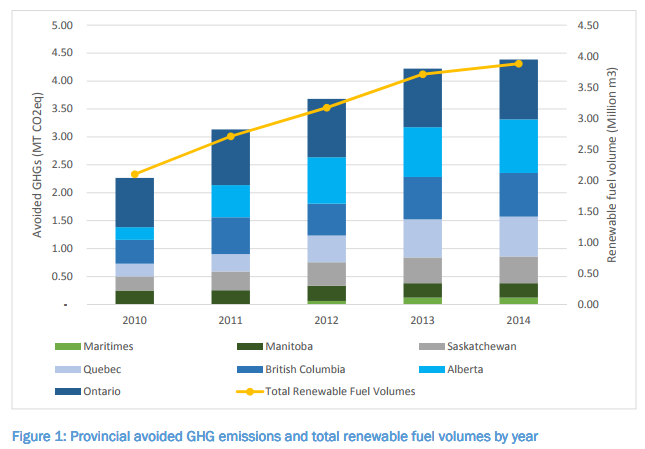While we make headway in reducing Ontario’s emissions in most sectors, transportation emissions continue to rise. Increasing the use of ethanol and other renewable fuels can be an important step in the transition to a low-carbon transportation system – contrary to what naysayers claim.
To reach Ontario’s climate targets, the provincial government recently proposed increasing ethanol requirements in gasoline. The Clean Economy Alliance, of which The Atmospheric Fund (TAF) is a founding member, responded with a public submission in support of an increased renewable fuel standard. The recommendations also call for more tools to support innovation and increased use of high-blend biofuels from waste-based sources.
Over the past years, a number of interest groups argued against the development of ethanol as a sustainable fuel source, and more generally, the effectiveness of a renewable fuel standard. To provide clarity on the debate, we decided to myth-bust some of the common misconceptions and highlight the environmental benefits of this policy tool.
Myth #1: Ethanol blending is not cost effective. If it were, fuel producers would be doing it in under existing cap-and-trade or carbon tax programs.
Fact: As welcome as carbon pricing mechanisms in Ontario (cap-and-trade) and British Columbia (carbon tax) are, they do not reflect the true cost of carbon according to Environment and Climate Change Canada. The prices under such programs are not high enough to drive the necessary level of carbon reductions on their own. To achieve established carbon emissions reduction targets, it is necessary to implement a suite of complementary policy tools, such as a renewable fuel standard.
Myth #2: Ethanol-gasoline blends can lower your car’s fuel economy.
Fact: While it is true that many cars will experience a slight reduction in fuel economy, the effect is minor and new generations of vehicles will eliminate this problem entirely. A research initiative by a national U.S. laboratory discovered that a traditional car modified for higher ethanol fuel blend (40 per cent ethanol and 60 per cent gasoline) actually had increased fuel efficiency. This is because ethanol contains a higher concentration of octane compared to gasoline, which results in higher performance of vehicles through faster acceleration or greater towing capacity.
Myth #3: Corn-based ethanol will increase the cost of food since it cannot be produced in large enough quantities to accommodate the renewable fuel standards without impacting food and agriculture systems.
Fact: With technological advances, we are relying increasingly less on feedstock such as corn that we also use for food consumption. A 2016 study demonstrated that by 2030, the U.S. could produce over a billion tons of biomass energy while still having sufficient land and resources to meet the country’s food and animal feed needs. Recently, non-food biomass feedstock options have increased to include corn husks and stalks, forestry residue and wood wastes from the pulp and paper industry, switchgrass and miscanthus, algae, and wet wastes. While these materials are not yet widely implemented, they garner substantial investments from government and private companies, with several successful projects already implemented.
Myth #4: Tailpipe emissions are the same for ethanol blended gasoline and conventional gasoline. Thus, ethanol blending does not reduce emissions.
Fact: Tailpipe emissions are not the correct way to measure carbon emissions associated with a fuel source. A better measurement is lifecycle emissions, which accounts for the carbon emissions associated with a fuel from production to tailpipe. To capture the total emissions reductions associated with ethanol, we must acknowledge that biofuels capture atmospheric carbon dioxide while growing in the field, reducing the overall GHGs attributed to that fuel. In fact, from a lifecycle perspective, ethanol produced by corn results in approximately 40 per cent fewer carbon emissions compared to gasoline, while ethanol produced with cellulosic feedstock result in 108 per cent fewer emissions compared to gasoline.
Myth #5: It takes more energy use to produce ethanol than it generates as a fuel.
Fact: Ethanol has a positive energy balance, meaning that the energy content of ethanol is larger than fossil energy used in its production. A substantial number of studies have demonstrated that ethanol contains more energy than was used to produce it. Furthermore, the energy efficiency of ethanol production continues to improve. A white paper on technological efficiency gains in ethanol production estimates that the carbon intensity of corn-based ethanol productions has dropped by more than 50 per cent since 2008. At the same time, ethanol producers extract slightly more ethanol from each bushel of processed corn.

Studies like this Clean Energy Canada report demonstrate that increased use of renewable fuel resulted in fewer lifecycle related carbon emissions in the transportation sector (see a chart from the report above) . In 2014, the most recent year for which studies exist, transportation-related emissions in Canada went down by 2 per cent (from a lifecycle perspective) due to renewable fuel content. Renewable fuel consumption is an important step towards the gradual decarbonization of our transportation system. With the facts this clear, we shouldn’t let special interest groups tell us otherwise.

